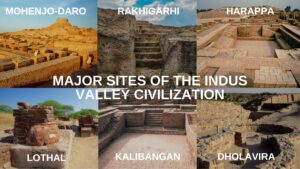The Indus Valley Civilization (IVC), also known as the Harappan Civilization, was one of the world’s earliest urban cultures, thriving between 3300 BCE and 1300 BCE. This Bronze Age civilization flourished in the northwestern regions of the Indian subcontinent, encompassing parts of modern-day Pakistan, India, and Afghanistan.
Initially named after the Indus River, subsequent discoveries revealed its vast extent beyond the river valley, leading scholars to prefer the term Harappan Civilization, after its first excavated site, Harappa.
Chronology and Phases of the Indus Valley Civilization
The timeline of the Indus Valley Civilization is broadly divided into three distinct phases:
| Harappan Phases | Important Sites | Key Features |
|---|---|---|
| Early Harappan (3300-2600 BCE) | Harappa, Amri, Kot Diji | Small settlements, development of trade networks, increasing specialization in crafts. |
| Mature Harappan (2600-1900 BCE) | Mohenjo-Daro, Harappa, Kalibangan, Dholavira | Full-scale urbanization, organized irrigation systems, emergence of writing, uniformity in artifacts, large-scale trade. |
| Late Harappan (1900-1300 BCE) | Late Siswal, Rojdi, Rangpur | Decline phase, abandonment of sites, emergence of new cultural traditions, rise of the pastoral economy. |
Key Features of the Indus Valley Civilization
1. Urban Planning and Architecture
The Indus Valley Civilization is remarkable for its well-planned cities, built using a grid system, with wide streets and a sophisticated drainage system. Major sites such as Mohenjo-Daro and Harappa had two distinct areas:
- Citadel (Upper Town): Contained important structures like granaries, assembly halls, and religious buildings.
- Lower Town: The residential area where people lived in well-structured brick houses.
Other notable architectural features include:
- The Great Bath (Mohenjo-Daro): A large water tank possibly used for religious rituals or purification.
- Granaries: Large storage facilities indicating surplus agricultural production.
- Wells and Drainage Systems: Houses had private wells and bathrooms connected to covered drains, showcasing advanced sanitation.
Read more about.. Chalcolithic Age UPSC Notes
2. Economy and Trade
The economy of the Indus Valley Civilization was based on agriculture, trade, and crafts.
- Agriculture: The people cultivated wheat, barley, peas, sesame, and cotton. They also domesticated animals like cattle, buffalo, sheep, and goats.
- Crafts and Industries: The civilization was known for its pottery, bead-making, metallurgy (copper, bronze, lead, tin), and textile production.
- Trade: They engaged in both internal and long-distance trade. Evidence suggests commercial ties with Mesopotamia, Oman, and Persia. The discovery of Harappan seals in Mesopotamia and Mesopotamian seals in the Indus region confirms this interaction.
3. Writing and Seals
The Harappan script, found on seals, pottery, and copper tablets, remains undeciphered. The seals often depicted animals such as unicorns, bulls, and elephants, along with inscriptions, possibly representing the names of merchants or trade transactions.
4. Religion and Social Life
- Religious Practices: The Harappans worshiped nature deities, including a proto-Shiva figure (Pashupati seal) and the Mother Goddess.
- Burial Practices: Different burial methods, including extended burials, pot burials, and secondary burials, indicate varied cultural traditions.
- Art and Culture: The famous “Dancing Girl” bronze statue from Mohenjo-Daro reflects artistic excellence and the presence of dance and music in social life.
Major Sites of the Indus Valley Civilization
While hundreds of Indus Valley sites have been excavated, some of the most prominent include:

1. Mohenjo-Daro (Sindh, Pakistan)
- Largest excavated city after Rakhigarhi.
- Home to the Great Bath, granaries, assembly halls, and a complex drainage system.
- Famous for the Dancing Girl statue and Pashupati seal.
2. Harappa (Punjab, Pakistan)
- First site discovered (1921) by Daya Ram Sahni.
- Large granaries, two-room barracks for workers, and Cemetery-H culture burials.
- Known for the red sandstone male torso sculpture.
3. Dholavira (Gujarat, India)
- Unique three-tiered city layout with a water conservation system.
- Signboard with Indus script.
- Discovery of stadiums and reservoirs.
4. Lothal (Gujarat, India)
- The only known dockyard of the Indus civilization.
- Evidence of rice cultivation and bead-making industry.
- Discovery of a double burial (male & female in a single grave).
5. Kalibangan (Rajasthan, India)
- Evidence of fire altars suggesting religious practices.
- Ploughed field surface, indicating advanced agriculture.
6. Rakhigarhi (Haryana, India)
- Largest Harappan site (550 hectares), larger than Mohenjo-Daro.
- Continuous occupation from 6000 BCE to 2500 BCE, showing gradual cultural evolution.
Decline of the Indus Valley Civilization
The reasons behind the decline of this great civilization remain debated among scholars. Some possible causes include:
- Climate Change: Shifts in monsoon patterns and prolonged droughts may have affected agriculture.
- Earthquakes or Floods: Natural disasters could have led to mass migrations.
- Decline in Trade: The fall of Mesopotamian trade networks may have impacted the economy.
- Aryan Invasion Theory (Contested): Earlier theories suggested an invasion by Indo-Aryans, but modern research emphasizes gradual decline rather than violent conquest.
- Resource Depletion: Overuse of natural resources could have led to economic downfall.
Read our previous Blog… Types of Stone Age: Palaeolithic, Mesolithic, and Neolithic
Legacy and Significance
The Indus Valley Civilization was far ahead of its time in urban planning, sanitation, and craftsmanship. Many of its features, such as planned cities, drainage systems, and standardized weights, influenced later cultures in the Indian subcontinent. The civilization remains an integral part of India’s and Pakistan’s historical and cultural heritage.


